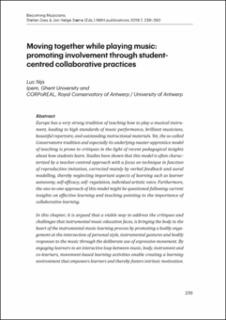| dc.description.abstract | Abstract -
Europe has a very strong tradition of teaching how to play a musical instrument, leading to high standards of music performance, brilliant musicians, beautiful repertoire, and outstanding instructional materials. Yet, the so-called Conservatoire tradition and especially its underlying master-apprentice model of teaching is prone to critiques in the light of recent pedagogical insights about how students learn. Studies have shown that this model is often characterized by a teacher-centred approach with a focus on technique in function of reproductive imitation, corrected mainly by verbal feedback and aural modelling, thereby neglecting important aspects of learning such as learner autonomy, self-efficacy, self- regulation, individual artistic voice. Furthermore, the one-to-one approach of this model might be questioned following current insights on effective learning and teaching pointing to the importance of collaborative learning. In this chapter, it is argued that a viable way to address the critiques and challenges that instrumental music education faces, is bringing the body to the heart of the instrumental music learning process by promoting a bodily engagement at the intersection of personal style, instrumental gestures and bodily responses to the music through the deliberate use of expressive movement. By engaging learners in an interactive loop between music, body, instrument and co-learners, movement-based learning activities enable creating a learning environment that empowers learners and thereby fosters intrinsic motivation. | en_US |
